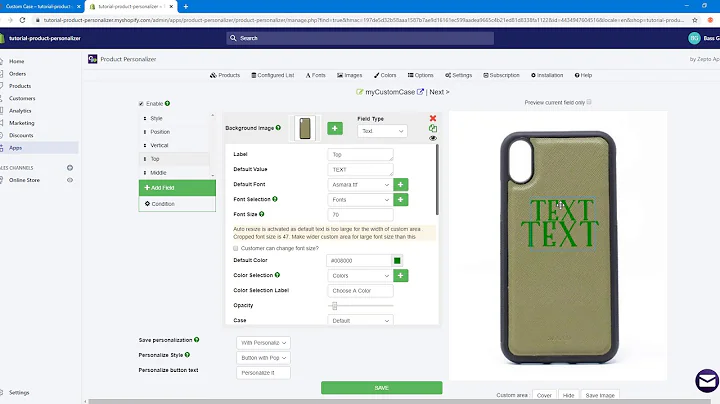Cracking the Code: Building Better Loyalty Programs for Success
Table of Contents
- Introduction
- Consumer Sentiment on Brand Loyalty
- Background of the Consumer Survey
- Importance of Consumer Loyalty
- Factors Influencing Brand Loyalty
- Building Better Loyalty Programs
- Strategies to Earn Consumer Loyalty
- Enhancing Customer Expectations
- Incorporating Brand Values
- Examples of Successful Loyalty Programs
- Sustainable Clothing Brand: Tentry
- Home Essentials Brand: Brook Linen
- Kids Footwear Brand: Play
- Going the Extra Mile for Customer Loyalty
- Consumer Preferences in Loyalty
- Direct-to-Consumer Shopping
- Waiting for Item Availability
- The Impact of Loyalty Programs
- Influence on Customer Loyalty
- Repeat Purchases and Brand Loyalty
- Online-Offline Connectivity in Loyalty Programs
- Importance of Mobile Engagement
- Earning Points on In-Store Purchases
- Consistency in Loyalty Program Accessibility
- Challenges and Opportunities of Omni-Channel Loyalty
- Challenges of Operating Brick-and-Mortar and E-commerce Shops
- Leveraging Loyalty Programs for Brick-and-Mortar and E-commerce
- Trends in E-commerce Marketing
- Personalization and Customization
- Leveraging Technology for Real-Time Adjustments
- Future Plans for NYDJ and Sunrise Brands
- Transition to a Lifestyle Brand
- Expansion into New Categories
- Sustainability Initiatives and Partnerships
The State of Brand Loyalty: Trends and Strategies for Success
Brand loyalty has become a critical aspect of business success in today's highly competitive marketplace. In a recent consumer survey conducted by Yappo, the state of brand loyalty in 2022 was examined, revealing fascinating insights into consumer behavior and expectations. This article explores the key findings of the survey and provides strategies for building better loyalty programs that resonate with customers.
1. Introduction
In an era where consumers have an abundance of choices, brands face the challenge of earning and maintaining customer loyalty. This article delves into the current state of brand loyalty, highlighting the importance of loyalty programs and consumer expectations. By understanding these factors, businesses can craft effective strategies to foster loyalty and improve customer retention.
2. Consumer Sentiment on Brand Loyalty
Background of the Consumer Survey
Yappo conducted a comprehensive survey of 3,800 global consumers, exploring their sentiments on brand loyalty. The survey captured valuable data from six different age groups across four demographics in five countries. While the official survey results are yet to be released, a sneak peek of the findings offers intriguing insights.
Importance of Consumer Loyalty
One key finding from the survey is that consumer loyalty is not guaranteed; it must be earned. A significant percentage of respondents, 38%, stated that they do not consider themselves loyal to a brand until they have made at least five purchases from that brand. This figure shows a substantial increase from the previous year, indicating that consumer expectations are higher than ever. Brands need to consistently deliver value and meet customer expectations to convert first-time purchasers into loyal advocates.
Factors Influencing Brand Loyalty
The survey also revealed that brand values play a pivotal role in fostering loyalty. A remarkable 84% of respondents stated that they are more inclined to be loyal to a brand whose values align with their own. This sentiment is particularly strong among Generation Z, with over 90% indicating a preference for brands that demonstrate strong values. Brands can no longer be neutral about social issues; consumers expect them to take a stand. By incorporating brand values into loyalty programs, brands can create a deeper emotional connection with customers and foster long-term loyalty.
3. Building Better Loyalty Programs
To succeed in this increasingly competitive landscape, brands must focus on building effective loyalty programs that resonate with customers. By following specific strategies, brands can enhance customer loyalty and drive repeat purchases.
Strategies to Earn Consumer Loyalty
One of the key strategies to earn consumer loyalty is to provide value consistently. Brands need to meet customer expectations and provide a seamless experience with every purchase. It is crucial to listen to customers' feedback and adapt accordingly to improve products or services continually. By exceeding customer expectations, brands can convert one-time purchasers into loyal advocates.
Enhancing Customer Expectations
As more brands enter the e-commerce space, competition for customer loyalty becomes fiercer. Brands must pay close attention to what their customers want and deliver on those needs consistently. Through personalized experiences, exclusive offers, and exceptional customer service, brands can differentiate themselves and create a loyal customer base.
Incorporating Brand Values
Incorporating brand values within loyalty programs is a powerful way to engage customers on a deeper level. Brands like Tentry, a sustainable clothing brand, have successfully integrated their values into their loyalty programs. Tentry plants 10 trees for every item purchased, allowing customers to track the positive impact they make on the environment. By structuring loyalty programs around social responsibility, brands can reinforce their brand mission and foster emotional connections with customers.
4. Examples of Successful Loyalty Programs
Several brands have effectively demonstrated the impact of incorporating loyalty programs that align with their brand values. Here are a few examples:
Sustainable Clothing Brand: Tentry
Tentry's loyalty program goes beyond traditional rewards by focusing on sustainability. For every purchase made, the brand plants 10 trees, allowing customers to tangibly see the positive impact they are making. The program includes an "impact wallet" where customers can track the trees they have planted through their purchases. This proactive approach engages customers and encourages them to play an active role in combating climate change.
Home Essentials Brand: Brook Linen
Brook Linen, a home essentials brand, offers a unique loyalty program that allows customers to earn points by donating to Habitat for Humanity. By incorporating charitable giving into their loyalty program, Brook Linen aligns its brand values with customers' desire to make a positive impact. This approach creates a sense of purpose and deeper emotional connection with the brand.
Kids Footwear Brand: Play
Play, a kids' footwear brand, takes a customer-centric approach to loyalty. They allow customers to donate their loyalty points to "Race for Good," supporting causes that matter to their customers. This initiative not only strengthens customer loyalty but also empowers customers to participate in meaningful causes. By providing a platform for customer engagement, Play builds a lasting bond with its customers.
As these examples demonstrate, there are numerous ways to communicate brand values and engage customers within loyalty programs. Brands that prioritize these efforts can create a stronger emotional connection with customers, fostering long-term loyalty.
5. Going the Extra Mile for Customer Loyalty
The survey revealed that customers are willing to go the extra mile for brands they are loyal to. This loyalty manifests in various ways, including direct-to-consumer shopping, enrollment in loyalty programs, and waiting for item availability.
Consumer Preferences in Loyalty
67% of loyal customers prefer to shop directly from brands, bypassing marketplace retailers. This preference highlights the importance of establishing a strong direct-to-consumer presence. By cultivating brand loyalty, businesses can attract customers who prioritize supporting the brands they love.
Direct-to-Consumer Shopping
Enrolling in loyalty programs is another way customers demonstrate their loyalty. 65% of loyal customers sign up for these programs, recognizing the value they offer. Brands can leverage loyalty programs to incentivize repeat purchases and reward customer loyalty effectively.
Waiting for Item Availability
When faced with out-of-stock situations, loyal customers often choose to wait for the item to become available again instead of purchasing from a competitor. This behavior showcases the power of loyalty. Brands that have established strong loyalty programs can mitigate the negative impacts of supply chain issues by retaining customers' loyalty.
6. The Impact of Loyalty Programs
Loyalty programs have a significant influence on customer loyalty and repeat purchases. According to the survey, 69% of respondents stated that loyalty programs make them more loyal to a brand. Furthermore, over 83% of respondents acknowledged that belonging to a loyalty program influences their decision to make repeat purchases. These statistics highlight the effectiveness of loyalty programs in fostering brand loyalty and driving customer retention.
7. Online-Offline Connectivity in Loyalty Programs
In today's digital age, online-offline connectivity is crucial for loyalty programs. Consumers expect seamless engagement with loyalty programs, whether they are shopping online or in-store. It is essential for brands to ensure consistency and accessibility across different channels to provide an optimal customer experience.
Importance of Mobile Engagement
48% of respondents expressed a desire to engage with loyalty programs on mobile devices while shopping in-store. This preference emphasizes the need for mobile compatibility and highlights the opportunity for brands to engage customers actively during their shopping journey.
Earning Points on In-Store Purchases
70% of respondents considered earning points on in-store purchases to be highly important. This finding underscores the significance of incorporating loyalty program benefits into the offline shopping experience. Brands with both e-commerce and brick-and-mortar presence should ensure their loyalty programs are consistent and accessible, regardless of the shopping channel.
8. Challenges and Opportunities of Omni-Channel Loyalty
Operating both brick-and-mortar stores and e-commerce platforms presents unique challenges and opportunities for brands. Seamless integration of loyalty programs across these channels is vital to maximize customer experience and foster loyalty.
Challenges of Operating Brick-and-Mortar and E-commerce Shops
Operating brick-and-mortar stores and e-commerce platforms on separate systems can pose challenges, such as manual account creation and disjointed loyalty program experiences. To overcome these challenges, brands should strive for a cohesive loyalty program that seamlessly integrates both channels.
Leveraging Loyalty Programs for Brick-and-Mortar and E-commerce
Successful brands leverage loyalty programs to bridge the gap between brick-and-mortar and e-commerce. By incentivizing in-store sign-ups and providing consistent rewards and benefits, brands can offer a holistic loyalty experience that transcends shopping channels. This integrated approach enhances customer loyalty and drives customer engagement across multiple touchpoints.
9. Trends in E-commerce Marketing
E-commerce marketing is continually evolving, and staying ahead of the trends is crucial for brand success. Two key trends in e-commerce marketing are personalization and technology-driven strategies.
Personalization and Customization
Personalizing the customer experience and delivering customized interactions is becoming increasingly important. Customers expect brands to understand their preferences and provide tailored recommendations and offers. By leveraging customer data and investing in personalization technologies, brands can create meaningful connections with customers, leading to improved loyalty and customer retention.
Leveraging Technology for Real-Time Adjustments
The rapid advancement of technology has provided brands with the capability to adjust marketing strategies in real-time. By monitoring customer behavior, brands can evaluate the success of loyalty programs and make necessary adjustments promptly. This data-driven approach enables brands to optimize their loyalty programs, ensuring they remain relevant and valuable to customers.
10. Future Plans for NYDJ and Sunrise Brands
NYDJ, as well as its parent company Sunrise Brands, have ambitious plans for the future. These plans include transitioning NYDJ into a lifestyle brand that offers head-to-toe outfitting, expanding into new categories, and launching sustainability initiatives and partnerships. By aligning with customer expectations and offering a broader range of products and services, NYDJ aims to strengthen its position in the market and foster long-term brand loyalty.
In conclusion, brand loyalty is a vital aspect of business success. By understanding consumer sentiment, implementing effective loyalty programs, and adapting to the evolving trends in e-commerce marketing, brands can cultivate enduring relationships with customers. By prioritizing loyalty, brands can not only increase customer retention but also minimize the impact of ongoing supply chain challenges and position themselves for long-term success.
Highlights
- Consumer loyalty cannot be taken for granted; brands must earn it by consistently delivering value and meeting customer expectations.
- Brand values play a significant role in fostering loyalty, with a high percentage of consumers preferring brands that align with their own values.
- Successful loyalty programs incorporate brand values, such as sustainability or social responsibility, to create deeper emotional connections with customers.
- Direct-to-consumer shopping and enrollment in loyalty programs are indicators of customer loyalty.
- Loyalty programs have a substantial impact on fostering brand loyalty and influencing repeat purchases.
- Mobile engagement and earning points on in-store purchases are essential for effective loyalty programs.
- Integrating loyalty programs seamlessly across online and offline channels is crucial for providing a cohesive customer experience.
- Personalization and customization are key trends in e-commerce marketing, enabling brands to create meaningful connections with customers.
- Leveraging technology allows brands to make real-time adjustments to loyalty programs based on customer behavior and preferences.
- NYDJ plans to transition into a lifestyle brand, expand into new categories, and launch sustainability initiatives to strengthen brand loyalty.
FAQ
Q: Are loyalty programs effective in improving customer retention?
A: Yes, loyalty programs have proven to be effective in improving customer retention. According to the consumer survey, a majority of respondents stated that loyalty programs make them more loyal to a brand and influence their decision to make repeat purchases.
Q: How can brands incorporate their values into loyalty programs?
A: Brands can incorporate their values into loyalty programs by aligning rewards and benefits with social responsibility initiatives. For example, a sustainable clothing brand can reward loyalty program members by planting trees for each purchase made.
Q: What challenges do brands face when operating both brick-and-mortar stores and e-commerce platforms?
A: Operating both brick-and-mortar stores and e-commerce platforms on separate systems can lead to challenges such as manual account creation and disjointed loyalty program experiences. Brands should strive to integrate loyalty programs seamlessly across both channels to maximize customer experience and foster loyalty.
Q: How can brands personalize the customer experience in e-commerce marketing?
A: Brands can personalize the customer experience in e-commerce marketing by leveraging customer data and employing technologies that enable tailored recommendations and offers based on individual preferences.
Q: How can brands adapt loyalty programs to meet customer expectations in an evolving market?
A: Brands can adapt loyalty programs by monitoring customer behavior, evaluating program success, and making real-time adjustments. By staying abreast of market trends and customer preferences, brands can ensure loyalty programs remain relevant and valuable to customers.


















